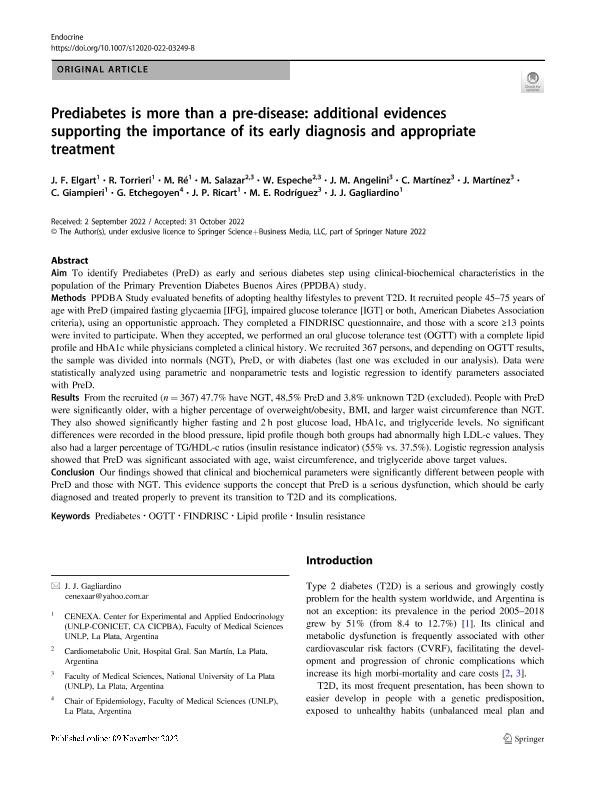Artículo
Prediabetes is more than a pre-disease: additional evidences supporting the importance of its early diagnosis and appropriate treatment
Elgart, Jorge Federico ; Torrieri, Rocio; Ré, Matias Alberto; Salazar, Martin; Espeche, Walter; Angelini, Julieta Maria; Martinez, Camilo; Martinez, Jorge Guillermo; Giampieri, Cecilia; Etchegoyen, Graciela Susana
; Torrieri, Rocio; Ré, Matias Alberto; Salazar, Martin; Espeche, Walter; Angelini, Julieta Maria; Martinez, Camilo; Martinez, Jorge Guillermo; Giampieri, Cecilia; Etchegoyen, Graciela Susana ; Ricart, Juan Pablo Antonio; Rodriguez, María Elvira; Gagliardino, Juan Jose
; Ricart, Juan Pablo Antonio; Rodriguez, María Elvira; Gagliardino, Juan Jose
 ; Torrieri, Rocio; Ré, Matias Alberto; Salazar, Martin; Espeche, Walter; Angelini, Julieta Maria; Martinez, Camilo; Martinez, Jorge Guillermo; Giampieri, Cecilia; Etchegoyen, Graciela Susana
; Torrieri, Rocio; Ré, Matias Alberto; Salazar, Martin; Espeche, Walter; Angelini, Julieta Maria; Martinez, Camilo; Martinez, Jorge Guillermo; Giampieri, Cecilia; Etchegoyen, Graciela Susana ; Ricart, Juan Pablo Antonio; Rodriguez, María Elvira; Gagliardino, Juan Jose
; Ricart, Juan Pablo Antonio; Rodriguez, María Elvira; Gagliardino, Juan Jose
Fecha de publicación:
09/11/2022
Editorial:
Humana Press
Revista:
Endocrine
ISSN:
1355-008X
e-ISSN:
1559-0100
Idioma:
Inglés
Tipo de recurso:
Artículo publicado
Clasificación temática:
Resumen
Aim: To identify Prediabetes (PreD) as early and serious diabetes step using clinical-biochemical characteristics in the population of the Primary Prevention Diabetes Buenos Aires (PPDBA) study. Methods: PPDBA Study evaluated benefits of adopting healthy lifestyles to prevent T2D. It recruited people 45–75 years of age with PreD (impaired fasting glycaemia [IFG], impaired glucose tolerance [IGT] or both, American Diabetes Association criteria), using an opportunistic approach. They completed a FINDRISC questionnaire, and those with a score ≥13 points were invited to participate. When they accepted, we performed an oral glucose tolerance test (OGTT) with a complete lipid profile and HbA1c while physicians completed a clinical history. We recruited 367 persons, and depending on OGTT results, the sample was divided into normals (NGT), PreD, or with diabetes (last one was excluded in our analysis). Data were statistically analyzed using parametric and nonparametric tests and logistic regression to identify parameters associated with PreD. Results: From the recruited (n = 367) 47.7% have NGT, 48.5% PreD and 3.8% unknown T2D (excluded). People with PreD were significantly older, with a higher percentage of overweight/obesity, BMI, and larger waist circumference than NGT. They also showed significantly higher fasting and 2 h post glucose load, HbA1c, and triglyceride levels. No significant differences were recorded in the blood pressure, lipid profile though both groups had abnormally high LDL-c values. They also had a larger percentage of TG/HDL-c ratios (insulin resistance indicator) (55% vs. 37.5%). Logistic regression analysis showed that PreD was significant associated with age, waist circumference, and triglyceride above target values. Conclusion: Our findings showed that clinical and biochemical parameters were significantly different between people with PreD and those with NGT. This evidence supports the concept that PreD is a serious dysfunction, which should be early diagnosed and treated properly to prevent its transition to T2D and its complications.
Palabras clave:
FINDRISC
,
INSULIN RESISTANCE
,
LIPID PROFILE
,
OGTT
,
PREDIABETES
Archivos asociados
Licencia
Identificadores
Colecciones
Articulos(CENEXA)
Articulos de CENTRO DE ENDOCRINOLOGIA EXP.Y APLICADA (I)
Articulos de CENTRO DE ENDOCRINOLOGIA EXP.Y APLICADA (I)
Citación
Elgart, Jorge Federico; Torrieri, Rocio; Ré, Matias Alberto; Salazar, Martin; Espeche, Walter; et al.; Prediabetes is more than a pre-disease: additional evidences supporting the importance of its early diagnosis and appropriate treatment; Humana Press; Endocrine; 79; 1; 9-11-2022; 80-85
Compartir
Altmétricas



